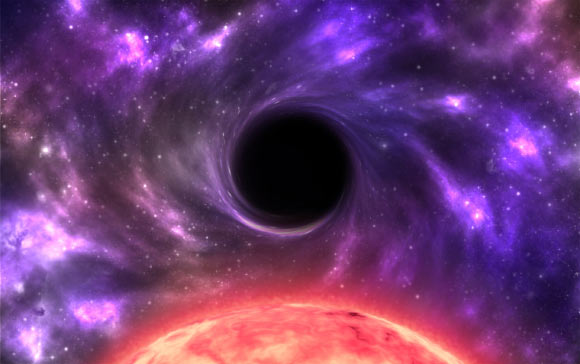New Class of Low-Mass Black Holes May Exist, Astronomers Say | Astronomy – Sci-News.com
In a paper published in the November 1, 2019 issue of the journal Science, a team of astronomers offers a new way to search for stellar-mass black holes, and shows that it is possible there is a class of black holes smaller than the smallest known black holes in the Universe.

An artist’s rendition of a giant star in orbit around a low-mass black hole. Image credit: Sci-News.com.
Stellar black holes often exist in something called a binary system. This simply means that two stars are close enough to one another to be locked together by gravity in a mutual orbit around one another.
When one of those stars dies, the other can remain, still orbiting the space where the dead star — now a black hole or neutron star — once lived, and where a black hole or neutron star has formed.
For years, stellar black holes astronomers knew about were all between 5 and 15 times the mass of the Sun. The known neutron stars are generally no bigger than about 2.1 solar masses — if they were above 2.5 solar masses, they would collapse to a black hole.
But in 2017, the LIGO Observatory detected two black holes merging together in a galaxy about 1.8 million light years away. One of those black holes was about 31 times the mass of the Sun; the other about 25 times the mass of the Sun.
“Immediately, everyone was like ‘wow,’ because it was such a spectacular thing,” Ohio State University’s Professor Todd Thompson.
“Not only because it proved that LIGO worked, but because the masses were huge. Black holes that size are a big deal — we hadn’t seen them before.”
Professor Thompson and colleagues had long suspected that stellar black holes might come in sizes outside the known range, and LIGO’s discovery proved that they could be larger. But there remained a window of size between the biggest neutron stars and the smallest black holes.
The scientists decided to see if they could solve that mystery.
They used data from the Apache Point Observatory Galactic Evolution Experiment (APOGEE), which collected light spectra from around 100,000 stars across the Milky Way.
The spectra could show whether a star might be orbiting around another object: changes in spectra — a shift toward bluer wavelengths, for example, followed by a shift to redder wavelengths — could show that a star was orbiting an unseen companion.
The researchers narrowed the APOGEE data to 200 stars that might be most interesting.
They then analyzed images of each potential binary system from the All-Sky Automated Survey for Supernovae (ASAS-SN).
Their data crunching found a giant star called 2MASS J05215658+4359220 that appeared to be orbiting a massive unseen companion.
This binary system has an orbital period of 83 days and lies in the constellation Auriga, approximately 12,068 light-years from Earth.
The massive companion emits no light, including X-rays. This indicates the presence of a black hole that is not currently consuming any material.
“Constraints on the giant’s mass and radius imply that the unseen companion is 3.3 solar masses, indicating that it is a noninteracting low-mass black hole or an unexpectedly massive neutron star,” the astronomers said.
“What we’ve done here is come up with a new way to search for black holes, but we’ve also potentially identified one of the first of a new class of low-mass black holes that astronomers hadn’t previously known about,” Professor Thompson said.
“The masses of things tell us about their formation and evolution, and they tell us about their nature.”
_____
Todd A. Thompson et al. 2019. A noninteracting low-mass black hole–giant star binary system. Science 366 (6465): 637-640; doi: 10.1126/science.aau4005






